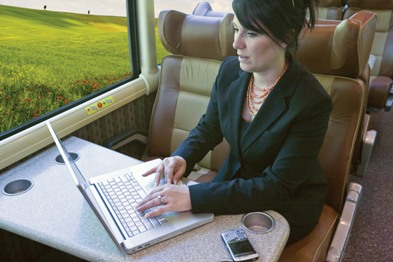
DePaul University survey finds passengers insist on total access to digital technology
By David Hubbard
The prevalence of portable electronics appears to change the dynamics of how Americans make travel choices. So says the latest study from the DePaul University Chaddick Institute for Metropolitan Development, Chicago, IL. Chaddick Institute Director Joe Schwieterman says in this day and age easy access to digital technology is an absolute must for the future success of public transport.
This past December Schwieterman and his team surveyed scores of buses, trains and planes to learn the prevalence of technology usage by more than 6,000 passengers traveling through 14 states.
The group, comprised of Schwieterman, Lauren A. Fischer, Steven Field, Andrew Pizzano and Susan Urbanczyk, found the trend much more pronounced among the lower-cost carriers that target college students and other young adult travelers. Amtrak corridors are not far behind, seeing more than 35 percent of passengers using portable technology and even higher use on high-speed Acela trains.
Get more great articles like this one with a subscription to BusRide!
Click here to subscribe.
The study suggests the capability to freely use portable technology is encouraging people who would otherwise fly or drive to take a second look at bus and train travel. Though considerably slower the availability of technology on buses and trains more than compensates for the longer travel time, the study concludes.
The role of electronic devices
While the use of portable electronics contributes significantly to the recent rise in popularity of intercity bus travel, the Chaddick Institute team believes research in general on the role of electronic devices in intercity travel has been slow to catch up to the phenomenon. They say they still have important unanswered questions. They want to know more about which modes of travel are most amenable to the use of portable electronic devices, and how people change their use of technology over the course of a trip. They hope to learn more about how people travel now and how they will travel in the coming years, and what role portable electronic devices will play.
 In the summer of 2007 DC2NY Bus was the first carrier to launch service between Washington D.C. and New York with free WiFi on its entire system. Megabus and Bolt Bus began offering free wireless access in 2008, and Greyhound is now jumping onboard.
In the summer of 2007 DC2NY Bus was the first carrier to launch service between Washington D.C. and New York with free WiFi on its entire system. Megabus and Bolt Bus began offering free wireless access in 2008, and Greyhound is now jumping onboard.
The study also reveals on airlines the rollout of WiFi has met with lackluster demand. No more than 18 percent of airline travelers use portable electronic devices at any given point in a trip, which some believe is due to high fees and the inconvenience of having to shut down computers and other devices for substantial periods of time during the beginning and end of flights.
The study quantifies the dramatic changes in long distance travel habits over the past 20 years. Travelers on long-distance bus, train and airplane trips used to occupy their time conversing with fellow passengers, reading, writing or napping. In that respect, little has changed, but travelers today do relish being trapped in what Schwieterman calls the travel bubble. He notes business travelers traveling incommunicado feel particularly chafed at being out of the loop.
“The information age has clearly changed the norm,” says Schwieterman. “An increasing number of travelers use cell phones, laptop computers and iPods not only for entertainment, but to make more productive use their time on the road.”
Loss of productivity
For business travelers, the cost of traveling is more than just the fare. They factor in the loss of productivity. In the old days they dashed to pay phones in the terminal to catch up on events back at the office. Today they travel equipped with laptop computers and cell phones followed by Blackberries, iPhones, notebook computers, compact memory devices, and a wide array of portable entertainment systems. Schwieterman says consumers have begun providing the communication and entertainment themselves, putting less emphasis on centralized systems.
The researchers conducted visual surveys to measure the use of two basic types of electronic devices: audio devices, such as cell phones and CD players, and visual devices such as the LCD screens of laptop computers, Blackberries DVD players and iPods. Their review produced six principal conclusions that show how technology use differs across travel modes and circumstances.
1. Use of technology on curbside buses is higher than on any other transportation mode on weekends and weekdays after 7 p.m.
2. The intense use of technology on curbside buses appears to be partially attributable to a young and savvy customer demographic that sees WiFi as a necessary amenity. Curbside bus operations typically benefit from virtually uninterrupted cell-phone signals with towers often erected often along Interstate highways.
3. The informal boarding of buses may also be significant. Passengers on planes and trains typically turn off portable devices before boarding due to stricter boarding procedures.
4. The rates of use of portable technology on Amtrak’s Acela Express greatly surpasses usage on all other modes during weekdays before 7 p.m. An estimated 48 percent of passengers are using portable technology at any given point. None of the weekday Acela trips had fewer than four in 10 passengers using technology at any time during the survey.
5. Greyhound has only about half the technology use as curbside bus operators. This is apparently due to the less affluent clientele that Greyhound serves and its types of line-haul. The lack of WiFi service on the majority of Greyhound routes appears to be only a secondary factor in explaining the low rates of technology use. Its passengers are less apt to use technology, which on conventional Greyhound trips averages just 17.6 percent. A mere eight percent of passengers use devices strictly for their audio capacity, which do not require Internet access.
6. Driver announcements may also play a role. On two trips, for example, the bus drivers asked passengers after dark to be as quiet as possible and to put cell phones on silent mode. One driver even threatened to stop the bus if this rule was violated
7. Technology users on curbside bus carriers and Greyhound divide their time almost equally between using audio features and visual features.
8. Only a small proportion of curbside bus travelers are traveling for purely business purposes. These passengers appear more apt to use music players and cell phones than DVD players and laptop computers. Bus travelers seem to use visual technologies for shorter durations than their rail counterparts.
9. On the average commercial flight the low usage does not appear to be a lack of interest in technology, but rather the lack of wireless connectivity.
10. The start and end of trips appear to be critical times for the use of communication devices. Once devices are turned off, many customers do not turn them back on until they disembark.
11. The types of portable technology devices that bus and train travelers use are remarkably consistent. There is a slight tendency for curbside bus travelers to shift away from using devices for their audio capacity in favor of visually oriented activities further into the trip.
12. These findings suggest that the growing prevalence and sophistication of portable electronic technology is diminishing the perception of time lost while riding on buses and trains.
Do you like this article? Subscribe TODAY to get
BusRide now available in digital!

Nice information, many thanks to the writer! It is good and correct. The usefulness and importance is overwhelming. Thanks again for this unbelievably powerful post and good luck!
This site has got some very helpful info on it! Thanks for helping me!
Hi! Awesome Job once again. I enjoy reading your website because you usually give us great posts. Very nice writeup.I plan to bookmark this blog. I think I shall subscribe to your feed also. Purchased a new cellular myself. Any one possess new sprint 4g phone?? It is so nice……